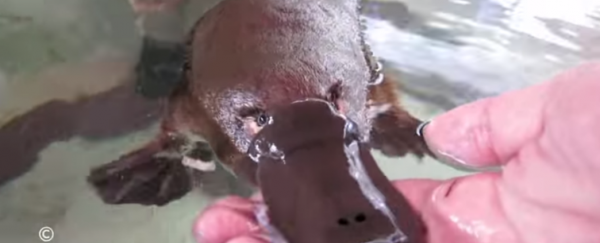
Found only in Australia and restricted to the country's eastern cost, you'd be forgiven for thinking these odd little creatures are in short supply, based on how infrequently they're seen in the wild. But the platypus is doing fine across its range, and those rare sightings are simply due to the fact that they're super-shy, and great at hiding in the murky depths of the freshwater pools and streams they inhabit.
That's what makes footage like this so appealing. Sure, this captive, hand-raised platypus is displaying completely different behaviour from its wild counterparts, but it's such a great opportunity to watch one up-close, feeding, nuzzling, and responding to some serious belly scritches.
One thing's for sure - if you were getting that close to a wild male platypus, you'd probably want to have your hospital escape route planned out, because they're one of the few species of mammals in the world that use venom to defend themselves . The males can deliver enough venom through the sharp, hollow spurs on their hind legs to kill a dog. And that's not the only strange thing about platypuses. There's a whole list of weirdness:
- They're mammals, but they lay eggs, so they're classified as monotremes. The only monotremes left on Earth are all indigenous to Australia and New Guinea.
- They don't have a stomach - their gullets connect directly to their intestines.
- Recent research suggests that their eyes are more similar to those of Pacific hagfish or Northern Hemisphere lampreys - so, sea creatures - than to other mammals.
- Mother platypuses have mammary glands to feed their hatchlings milk, but they don't have any teats with which to deliver it. Instead, she releases milk through pores in her skin, which accumulates in grooves on her abdomen, where her young lap it up over of the course of three to four months.
- Platypuses can spend up to 10 hours in the water at any one time, usually coming up for air every couple of minutes. But if it's intent on staying hidden from a threat, the high concentration of myoglobin - oxygen-binding proteins - in their lungs allow them to stay underwater for up to 10 minutes.
So, captive platypuses can be very cute, according to the video above, but here's something extra special - a wild platypus making an epic journey on land to get to a nearby creek.
Captured by Tasmanian filmmaker Max Moller late last year, this footage is the result of SEVEN YEARS spent trying to film useable images of the elusive species in the wild. "We were filming platypus in the area when he saw something moving through the grass. Thinking it was some huge lizard, we couldn't believe it when we saw this platypus walking between one creek to another," Moller told Ros Lehman at the ABC. "Filming platypus is one of the hardest tasks ever, but sometimes the luck is on your side and, with the amazing job from my assistant, we have managed to film this animal for around five minutes."
Source: ABC News
